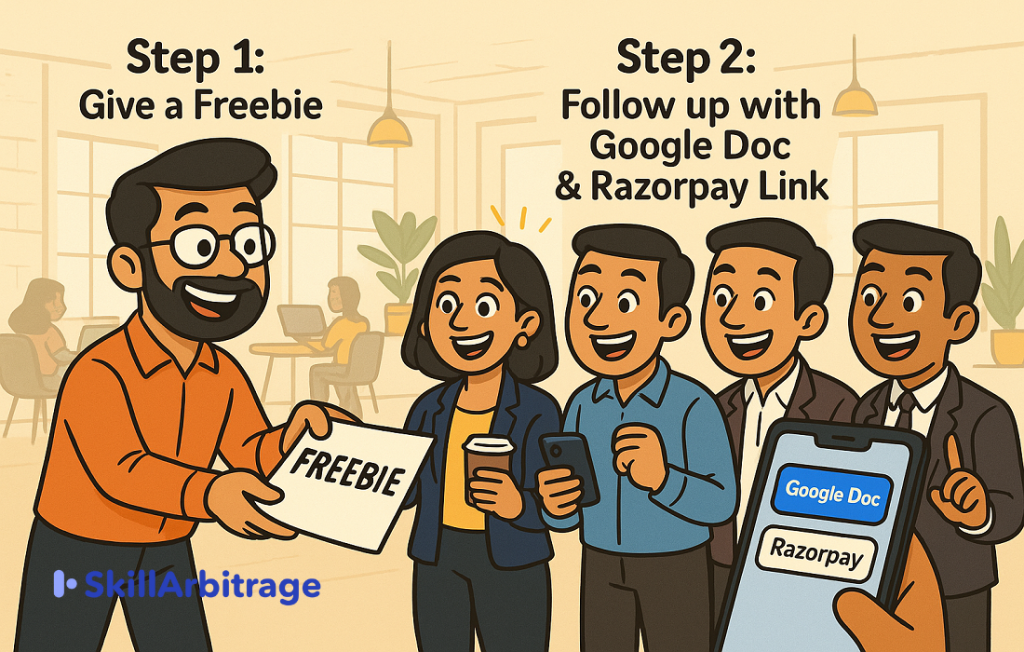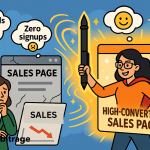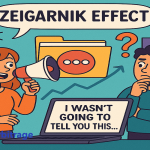“Freebie” is the key to turning followers into buyers. This article is for Indian freelancers who want to stop collecting likes and start collecting payments. It shows you how to use a dead-simple 2-step funnel built around a well-crafted freebie to sell your first digital product. No ads, no website, no tech stack. Just a strong offer, a small ask, and a funnel that filters buyers from browsers. By the end, you will know how to turn free into real revenue and how to help your clients do the same.
Table of Contents
Previously on Preframing…
Raja, Savitha, and Harsh learned the art of Preframes from Neel Marathe and saw how BareMode uses them to prime cold traffic before the pitch. Now Raghunandan flips the script. He challenges them to build and run their own 2-step funnels so they don’t just consult on strategy, they’ve lived it.
(Continued…)
Raghunandan had told them to come over. No context. Just a time.
Savitha, Harsh, and Raja were used to his erratic rhythms, midnight rants, and morning silences, but this felt off. His house was quiet. No lights in the hall. No jazz or Tamil film music in the background. No laptop on the table.
Just stillness.
They hovered near the dining table, unsure whether to sit or leave.
Then he walked in from the balcony.
No hello. No coffee. Just this:
“Someone once told me I wasn’t a real entrepreneur.”
They looked up.
“This was a client,” he said. “Blue tick. Big list. We were on a Zoom call. I was breaking down a funnel. Clean, low-lift, frictionless. Halfway through, they stopped me.”
‘You’ve never run your own funnel, have you?’
“I didn’t respond. They didn’t wait.”
‘See, I can’t work with consultants who only give advice. If you haven’t felt the risk, you don’t know how to sell.’
The call ended early.
“So I built one,” Raghunandan said. “No team. No tools. No tech drama.”
He let that hang.
“₹0 spent. ₹1 lakh a month now. Quiet, boring, consistent. It just works.”
He pulled out his phone. Opened a DM. Showed them the exact message that still drives sales. Then the freebie. Then the doc.
“This is how I sell. This is how I learn. And this is why I called you here.”
Silence.
Harsh broke it. “So… we’re doing this too?”
Raghunandan nodded.
“You’re not just building Neel’s funnel. You’re building your own. Doesn’t have to go viral. Doesn’t have to convert like crazy. It just has to exist.”
A pause.
“Because you can’t sell a funnel you haven’t run.
Clients smell theory. They trust skin in the game.
Once it works?
Pitch it to solo creators stuck in Notion purgatory.
To coaches waiting for ‘perfect timing.’
To B2B brands hoarding PDFs no one reads.
That little funnel you built? That’s your case study.
The freebie is your icebreaker.
The doc is your closer.
Everything else is noise.”
1. The Freelancer’s Funnel: Why You Only Need 2 Steps
Savitha leaned forward. “Wait. That’s it? A freebie and a Doc?”
“That’s it,” Raghunandan said.
Harsh squinted. “No landing page? No welcome email? No 17-step funnel diagram with arrows and color codes?”
Raja laughed. “He said ‘quiet, boring, consistent.’ Not ‘webinar death trap.’”
Raghunandan smiled. “Look, most funnels collapse under the weight of their own ambition. Fancy automations. Endless follow-ups. Tools no one knows how to use. The minute it breaks, you ghost the lead or lose the sale.”
He tapped his phone again.
“This one survives because it’s idiot-proof. It’s built for tech laziness.”
He drew two boxes on the whiteboard. Nothing else.
Box 1: The freebie.
“Something small. Sharp. Specific. It solves a real problem in 5 minutes. Not 50. It proves you’re worth listening to and worth paying.”
He looked at Savitha. “You already have one. That unscripted ad swipe file? That’s your freebie.”
To Harsh: “Your subject line teardown thread? Pick the best one. Turn it into a one-pager. That’s your freebie.”
To Raja: “Your DMs to that B2B founder about pricing psychology? Edit and ship. That’s your freebie.”
Then he pointed to the second box.
Box 2: The Doc.
“No fluff. No slide decks. Just a short, punchy Google Doc that connects the dots. What you believe, what you offer, how it works, and what happens next.”
“Simple doc. Simple link. Simple decision.”
He paused.
“That’s the freelancer’s funnel.”
You don’t need a tech stack.
You don’t need a team.
You don’t even need a damn website.
You just need two things:
- A hyper-specific freebie that proves you’re worth paying.
- A no-fluff Google Doc that turns interest into impulse buy.
That’s it.
You build it once. Then you test it, tweak it, send it, forget it, reshare it, cold-DM it, drop it in a comment, and turn it into a pinned tweet.
Because the funnel isn’t a website.
It’s a conviction wrapped in convenience.
And when it works, you don’t just have leads.
You have proof.
2. The Freebie Filter: How to Attract Buyers (Not Browsers)
Harsh pulled out his phone. “So what makes a freebie good?”
Raghunandan looked at him like he’d just asked if pizza needs cheese.
“A good freebie doesn’t impress,” he said. “It converts.”
Savitha raised an eyebrow. “Into what?”
“Into qualified buyers. Not fans. Not followers. Not people who ‘love your vibe.’ People who pay.”
He pulled up the freebie he’d used. It wasn’t pretty. Just a sharp title, a plain-text preview, and a link behind a DM.
“This thing solves one problem,” he said. “Not five. Not ‘value-packed.’ Just one thing they already want solved.”
Raja nodded slowly. “So it’s not a PDF buffet.”
“Nope,” Raghunandan said. “It’s a filter. To attract people with skin in the game and repel everyone else.”
Harsh scrolled through his own Notion files. “I have, like, five free guides.”
“Kill four,” Raghunandan said. “Pick the one that hits like a punch. Make it useful enough to act on, but not so complete they don’t need you.”
“And don’t just post a link,” he added. “Make them DM you for it. That friction filters out the tourists.”
Savitha blinked. “But won’t that reduce downloads?”
“Yes,” he said. “Exactly.”
That landed.
Because it wasn’t about volume.
It was about intent.
A good freebie:
– Solves a real, narrow problem
– Attracts people who are already feeling the pain
– Adds a little friction, so you know they care enough to ask
– Repels the ones looking for dopamine instead of change
“It’s not about looking smart,” he said. “It’s about attracting the people who already want to move.”
He paused.
“Browsers say ‘nice freebie.’
Buyers say, ‘how much is the full thing?’”
3. The Google Doc Pitch: How to Sell Without Selling
Raja leaned forward, still chewing on the last point. “Okay. Let’s say the freebie lands. They DM. They bite. Then what?”
Raghunandan didn’t miss a beat.
“Then you send them the Doc.”
Harsh frowned. “Like… a Google Doc?”
“Yes,” Raghunandan said. “Not a landing page. Not a Notion site. Just a clean, stupidly simple Doc.”
Savitha looked skeptical. “Won’t that feel… amateur?”
“That’s the trick,” Raghunandan said. “Docs lower resistance. People expect clarity, not design. It’s anti-marketing.”
He opened the one that powered his funnel. Title up top. Quick intro. Screenshots. One link at the bottom.
“This isn’t a brochure. It’s a conversation,” he said. “You’re not selling like a closer. You’re explaining like a friend.”
The format was brutal in its simplicity:
- One short paragraph: what the product is and who it’s for
- One proof section: screenshot, testimonial, or before/after
- One offer: price, delivery, what they get
- One link to pay
“That’s it?” Harsh asked.
“That’s it,” Raghunandan said. “If they’ve read the freebie and DM’d for more, they don’t need fireworks. They need a way to say yes.”
He clicked the payment link at the bottom. Razorpay.
“You can use Gumroad, Lemon Squeezy, whatever. But don’t wait to ‘build a funnel.’ This is the funnel.”
Raja was quiet, scanning the Doc again.
“It’s weirdly honest,” he said.
“That’s why it works,” Raghunandan said. “It doesn’t feel like selling. It just answers the one question that matters.”
Savitha looked up. “Which is?”
“‘Should I trust this person with my money?’”
And the Doc, plain as it looked, did exactly that.
No flair. No countdown timers. No testimonials from strangers holding coffee cups.
Just a clear problem. A clean offer. A human tone.
The kind of pitch that doesn’t try to convert everyone, just the right one.
4. Micro-Offers, Macro-Impact: What to Sell When You’re Unknown
Harsh was quiet for a moment, staring at the Razorpay link on Raghunandan’s Doc. Then he asked what everyone was thinking.
“But what are we selling exactly?”
Raghunandan smiled. Not smug. More like he’d been waiting for that question.
“You’re not selling your life’s work,” he said. “You’re selling a single solution. A tool, not a toolkit.”
“Micro-offers,” Raja said, clicking in. “Low price. High intent.”
“Exactly,” Raghunandan nodded. “₹500 to ₹1500. Small enough to buy without a call. Specific enough to actually help.”
He turned his phone around again. Showed them a teardown he sold for ₹999, just 5 pages breaking down a sales page that had gone viral in his niche.
“It’s not passive income,” he said. “It’s permission. You’re getting paid to build proof.”
Savitha pulled out her notebook. “So what qualifies as a good micro-offer?”
“Three rules,” Raghunandan said.
“One tool. For one job. For one kind of person.”
“Like a 30-minute onboarding script for new coaches,” Savitha said, thinking aloud.
“Or a plug-and-play sales deck for indie SaaS,” Raja added.
“Exactly,” Raghunandan said. “No Franken-products. No bundles. No 12-bonus-module ‘mini-courses.’ This isn’t a sale. It’s a trust exercise.”
Harsh flipped back a few pages in his own notes. “So… the point isn’t to make money?”
“Not yet,” Raghunandan said. “It’s about reputation. It’s about having something to point to when someone says, ‘But what have you built?’”
“And once you’ve made one,” he continued, “you can clip it, quote it, reuse it. It feeds your content. It sharpens your pitch. It grows you.”
The room went quiet again. Not out of confusion but out of clarity.
This wasn’t about building a funnel business. It was about building a name.
And sometimes, all it takes is one tiny product to do that.
5. The Invisible Funnel: How Free + Doc Turns into Real Revenue
Raja leaned back, arms crossed. “Okay, so the freebie pulls them in. The Doc closes. But then what?”
Raghunandan didn’t answer right away. He just pulled up his Telegram channel.
New subscriber. New subscriber. New buyer.
Then he tapped on a forwarded message: someone had shared his freebie in a private Slack group. Another had posted it in a subreddit. Quiet virality.
“That’s the thing,” he finally said. “You don’t have to push it. If it’s good, it spreads. The freebie gets passed around. The Doc handles the rest.”
Savitha tilted her head. “So it’s not really a funnel.”
“It is,” Raghunandan replied. “Just not one anyone can see.”
“You’re not running ads. You’re not doing retargeting. You’re not building a 9-email sequence.”
“You’re filtering.”
He looked at Harsh. “The freebie tells you who’s serious. The Doc tells them you’re serious. The buy button’s just a handshake.”
Harsh was scribbling fast now. “So every sale… is what? Validation?”
“Proof,” Raghunandan said. “Proof you’re not just another freelancer with theories. Proof your ideas work in the wild.”
“And once you’ve got ten people who paid ₹999 for that PDF?” he continued, “You’ve got a list. You’ve got fans. You’ve got leverage.”
Savitha raised an eyebrow. “And what do we do with that?”
“You make the next thing,” Raghunandan said. “And this time, you don’t have to guess what people want. They’ll tell you.”
He looked at all three of them.
“You’re not launching. You’re compounding. You’re building a small engine that runs on trust and delivers proof.”
“And every sale?” he added. “It’s not just money. It’s fuel.”
Raja grinned. “So it’s not a funnel you scale. It’s a funnel that stacks.”
“Exactly,” Raghunandan said. “And by the time clients come knocking, they won’t ask if you’ve run a funnel before. They’ll be standing in one.”
(To be continued…)







 Allow notifications
Allow notifications
